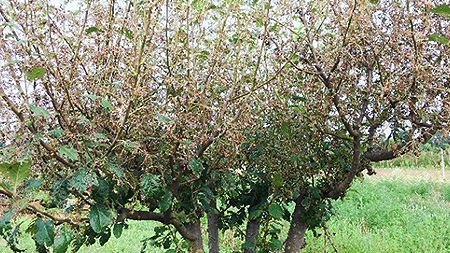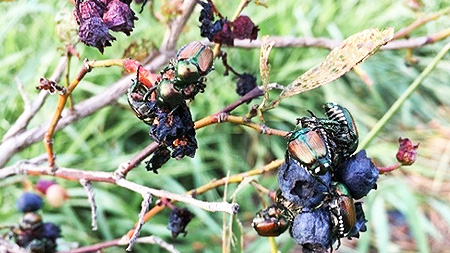The economic impact of the Japanese beetle
The Japanese beetle is a polyphagous species, meaning that it can feed on numerous host plants/crops. This makes the beetle a threat to agriculture, as its diet also includes important crops such as maize or soy. By feeding on the leaves and the ripe fruit of host plants, the adult beetle harms plant photosynthesis abilities and reduces farmer´s yield and harvest quality. Furthermore, Japanese beetle larvae can also cause substantial damages. The grubs develop beneath the soil and feed on the roots of plants or turf. The damages of the larvae to turf and grassland adversely affects sports facilities such as soccer fields and/or golf courses.
Host plants
The Japanese beetle has over 300 different host plants/crops, implying a wide variety of plants to feed on. Some of these host plants/crops such as soybeans, grapes, apples or blueberries are of economic importance to farmers. Depending on the availability of host crops, the beetle can also feed on the leaves of trees such as hazel nut, oaks, or linden. For a full list of Japanese beetle host plants including classifications into main or secondary host, see Tayeh et al. 2022.
Yield loss estimates from the literature
Depending on the Japanese beetle’s preference for a specific crop, the infestation level and the availability of plant protection products, estimated yield loss can vary greatly. An overview of yield loss estimates for some of the beetle’s main host plants/crops is presented below. Caution should applied to the interpretation of these figures, given that these yield loss estimates depend on the particular study framework and cannot be generalized.
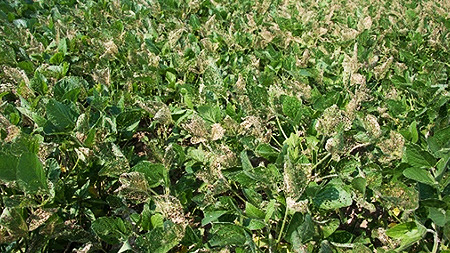
Soy
-
Ribero et al. (2022): reduction in seed size but no total yield damage could be observed (US)
-
EFSA et al. (2019): between 0% - 10% (Europe)
-
Gould (1963): 20% for heavily infested field (US)
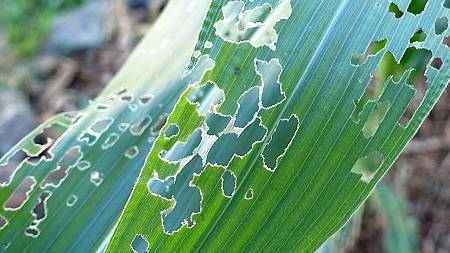
Maize
-
EFSA et al. (2019): between 0% - 10% (Europe)
-
Steckel & Tindall (2013): 0% - 32.4% reduction in total kernel weight (US)
-
Gould (1963): 10 bushels per acre for heavily infested fields (US)
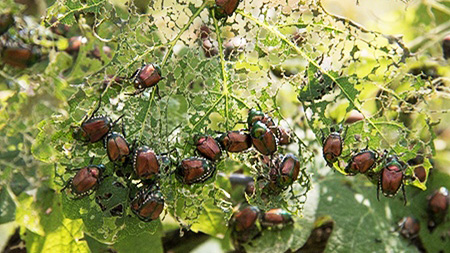
Grapevine
-
Ebbenga et al. (2022): no total yield reduction could be observed but negative impact on quality (US)
-
EFSA et al. (2019): between 1% - 20% (Europe)
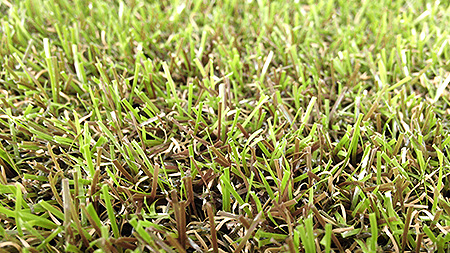
Turf / Grassland
-
EFSA et al. (2019): between 1% - 20% (Europe; turf of sport fields)
-
Ladd & Buriff (1979): between 12% - 100% (bluegrass)
Total damage estimates
The total economic damage caused by the Japanese beetle is composed of direct and indirect economic losses and costs, such as
-
agricultural yield and quality loss,
-
replacement costs,
-
costs and environmental consequences of additional control measures, applied by farmers, private persons as well as national plant protection services,
-
costs to non-agricultural businesses such as golf courses,
-
potential employment loss,
-
costs due to import and export regulations in the event of an infestation, and
-
indirect costs for economic sectors, which are connected or dependent on goods or services from directly affected sectors.
Currently only few studies have tried to estimate above-mentioned costs. According to USDA/APHIS (2015) costs for the control of the Japanese beetle in the US exceed US$460 million per year. In the European Union, the beetle has been ranked the second most important quarantine pest for crops due to its potential severe economic, social and environmental impacts. Even though no extensive damage has officially been reported for the case of Europe, a recent study of the IPM Popillia project found that the potential damage costs could be substantial. The potential yield damage to six main host crops of the beetle ranges from €30 million to €7.8 billion per year. Large grape and wine producing countries like France or Italy would be affected with potential annual damage costs of around €92 million and €62 million, respectively.

